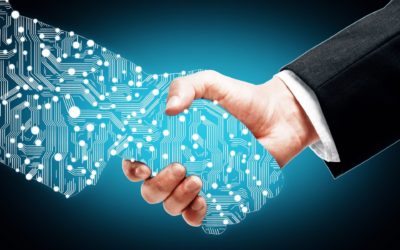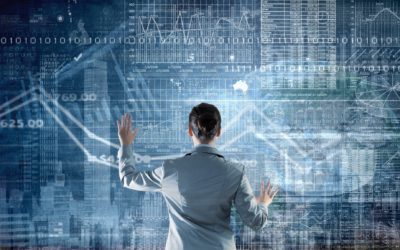Internet of Things - one of the most important buzz words of our time. In this article, we discuss how the IoT produces an enormous amount of data and what implications the increasing connectivity presents for private households.
After the computer engineer Tony Fadell developed the iPod and iTunes for Apple, he was looking for new challenges. He subsequently founded the company Nest, which developed the first intelligent thermostat developed. In 2014, a few years after its founding, Google bought the company for more than $3 billion, and the term Internet of Things arose.
Since that time at the latest, the industry has found itself around the Networking everyday things in turmoil. Since then, countless start-ups, medium-sized companies and large corporations have been developing a large number of innovative, networked products. Hardly any industry is growing as rapidly as the one around the Internet of Things: After current estimates 50 billion things are expected to be networked with each other by 2020. That means one thing above all: a lot of data.
Inhaltsverzeichnis
The IoT as a data source.
The increasing networking of things creates enormous amounts of data. According to IoT Barometer 2017/18 from Vodafone Around 80 per cent of companies expect that by 2022, data from the IoT will be used in more than every second Business process will play a relevant role. So it is not only private households that benefit from the networking of things, but also industry - or more precisely, Industry 4.0. In addition to the networking itself, one of the biggest challenges associated with it is how to deal with the Data volumes. We believe that data science is the key to unlocking the full potential of the Internet of Things.
The prerequisites and challenges of the Internet of Things.
The technical prerequisite for the Internet of Things and its subsystems, such as the Smart Home, is the miniaturisation of chip, sensor and radio technology. This makes it possible to store a certain amount of information directly on the object, to network the objects and thus to include even the smallest things in a larger, intelligent network.
How central the Saving and evaluating data in IoT solutions will be illustrated with a few examples. A networked toothbrush, for example, registers how long and with what pressure the teeth are brushed and thus contributes to an improvement in oral hygiene and, in the long term, the health of the teeth. The Fraunhofer Institute for Building Physics has calculated that intelligent thermostats can save an average of 18 percent energy. If we look only at single households, the figure is as high as 40 percent, and 22 percent for senior citizens.
Under the term "Ambient Assisted Living (AAL) All smart home technologies that make the lives of senior citizens easier are summarised in the term "smart home". Smart carpets or floors can distinguish whether a person is walking over it normally or lying motionless on it. Networked carpets can be embedded in scenarios: When a person gets out of bed at night and steps on a networked carpet in front of the bed, a light can automatically come on to minimise the risk of falling while walking to the toilet.
The Main effects and benefits of the networking of things in private households:
- Increasing comfort and well-being
- An improvement in safety through Intelligent safety concepts (networked smoke detectors, systems to protect against burglars)
- Exploiting the potential in energy consumption
- Intelligent energy management for energy-producing households
- Achieving a higher degree of individualisation
The greatest challenge in this area is not simply to increase the number of networked things and thus the number of possible scenarios. Rather, the development of sensible applications and Utilisation concepts are the focus of the companies.
The right Questionwhich is at the heart of IoT solutions, is the key to meaningful applications. Switching on the light in a smart home with the help of a smartphone is in many cases more complicated than activating a conventional light switch. Only the development of digital assistants such as Siri, Alexa & Co., brought decisive relief here. Digital assistants can therefore be an important component in the development and use of networked products as well as the correct collection and evaluation of data.
Link tip: What are the success factors in the implementation of Chatbots? Our expert for digital assistants gives the answers.
New business models as consequences of networking in the private sphere.
Depending on Degree of networking The demands on data management and therefore on the Data governance. The data generated in a smart home poses opportunities and challenges not only for the private user himself, but also for companies. On the one hand, the data creates a new transparency about individual behaviour within their own four walls. This enables the residents of a smart home to optimise their electricity consumption, for example, or to adopt a healthier lifestyle.
On the other hand, networking within the framework of the Internet of Things is at the same time giving rise to a New relationship between manufacturer and entrepreneur. Because not only things and their users are networked, but also companies and their customers. This creates new opportunities and perspectives around the Customer Journeyas a relationship between company and customer persists far beyond the purchase of a product.
New Business models like Telematics tariffs in the insurance industry will become possible as well as new maintenance concepts, such as Predictive Car Maintenance. Last but not least, companies also benefit directly from the IoT - for example in the form of new working environments such as the smart building or the smart factory.
The Internet of Things enables the New Way of Working.
The Internet of Things turns the private citizen into a small businessman.
Last but not least, the Internet of Things is blurring and permeating the traditional boundaries between companies and customers or between producers and consumers. A networked solar system on the roof or a networked micro-cogeneration plant in the basement will turn customers not only into electricity consumers, but also into consumers of energy. Power generator. As soon as their own needs are met, the additional electricity generated by a plant can be fed into the grid.
Link tip: In order to be able to use the large amount of data from the IoT, companies are relying on machine learning - for example in the energy industry.
The prerequisites for this are again Intelligently networked systems - in this case a smart grid - and the ability to process the data in corresponding Data Science Use Cases to make them usable.
The Internet of Things leads to a Duplication of interfacesas any number of objects can be networked with each other. In addition to the primary functions of the networked things, these interfaces generate large amounts of data (Big Data), which also hold enormous potential. In order to make use of the new business models linked to this, the following are required intelligent solutions and Data Science necessary.



![What is Edge Computing - [at] Blog Basics](https://www.alexanderthamm.com/wp-content/uploads/edge-computing-blog-400x250.jpg)




0 Kommentare